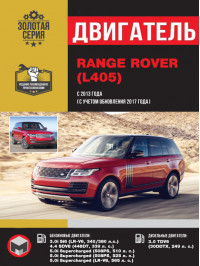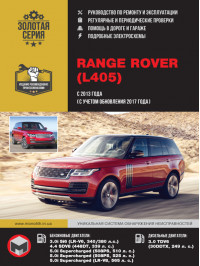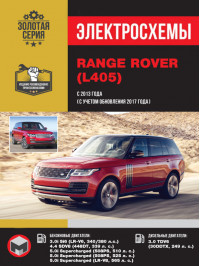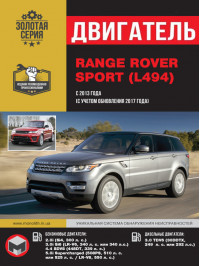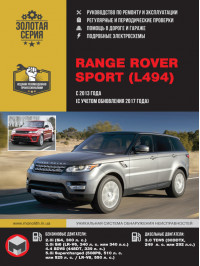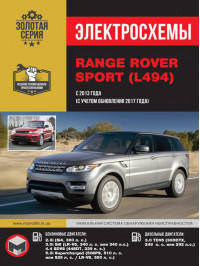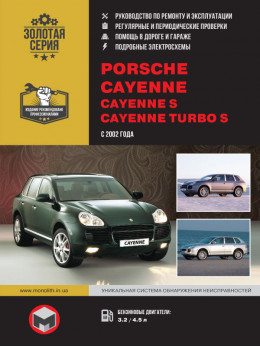Information on repair and maintenance of The fourth generation Range Rover (2012-present) cars electronically
The fourth generation Range Rover was first unveiled on September 6, 2012 at the Paris Motor Show as the Range Rover Parigi Concept. Serial production began just a few days later. The design studio and bodybuilding company Vercarmodel Saro was involved in the development.
The car has been completely redesigned. The Range Rover now features a monocoque body made of aluminum, which is 150 kg lighter than the sheet steel body of the previous model. When creating this body, engineers used the experience gained in developing the aluminum Jaguar XJ sedan.
Characteristics of Fourth generation Range Rover
The body side of the new Range Rover is said to be the largest single-piece extruded part in the automotive industry, designed to reduce weight and increase strength. The body uses 270 aluminum stampings, 14 cast parts and another nine extruded parts. The aluminum frame is fixed using 160 g of adhesive joints and 3722 rivets of various types.
The headlight design, a first on this vehicle, has created a headlight signature by combining LEDs and light guides, giving the Range Rover a unique and individual look. In normal mode it operates as a daytime running light and dims slightly at night or when the low beam is switched on and takes over the function of the parking light.
For the first time, the Range Rover can also be ordered with two wheelbases and a 2-seater rear seat separated by a center console. It is an extension of the front center console and offers rear seat passengers control of the rear climate zones, massage function, heated and air conditioned seats, as well as an optional cooled storage compartment under the armrest and a remote control for the optional rear entertainment system.
In the European market of the fourth generation Range Rover SUV (factory index L405), three types of engines are available: a gasoline 5.0 V8 and two diesel engines - 3.0 V6 and 4.4 V8. All of these engines are mated to an eight-speed automatic transmission manufactured by ZF.
Due to weight savings, a six-cylinder diesel engine is again used for the first time since 2006, with power output similar to that of the previous Range Rover TDV8.
The new generation of the car has added another mode, intermediate, which raises the body by 40 mm for driving on light off-road conditions. The total movement of the body is increased, and its lift height reaches 35 cm at the peak (303 mm). The suspension is one of the innovations that helped the car reduce weight. The aluminum subframe saved 14 kg compared to its steel counterpart. Another important innovation is the electric power steering, which changes the degree of assistance depending on the speed.
The rear suspension with aluminum lower control arm is also new. It should also be noted that the body automatically levels itself during loading. The Adaptive Dynamics system analyzes vehicle movement 500 times per second and reacts to changes in road terrain and driver input by adjusting the shock absorbers. This helps reduce body roll when cornering, which, combined with other innovations, improves the model's handling while maintaining a high level of comfort.
Next-generation Terrain Response 2 Auto analyzes current driving conditions and automatically selects the most appropriate vehicle settings, including transmission, suspension and throttle response. Manual setting allows you to choose from several situations, such as "Grass, Gravel or Snow", "Mud, Ruts", "Sand" and "Rocks". In the latter case, careful rolling over large boulders is provided. This mode, by the way, was not present on the Range Rover Evoque crossover, where the updated Terrain Response system debuted.
The list of electronic assistants also includes stability control, hill descent control, hill start assist, cornering braking control, traction control and a rollover prevention system. Interestingly, the new Range Rover stores more than nine kilometers of wires and cables.
Fourth generation Range Rover service manual
Repairing a car is a really expensive undertaking, which is why some Range Rover owners prefer to do it themselves. Special technical literature will help with this.
On our website you can read, purchase and download a Range Rover repair book in PDF format for free. In this guide you will find answers to various questions such as:
- finding engine faults and eliminating them;
- replacing fuel and cabin filters;
- proper repair of brake discs and pads;
- chassis repair and much more.
To ensure that the Range Rover repair book is always at hand and can help you in any situation, it is best to purchase and download it to your smartphone in PDF format.
The information in the book is presented in simple language and will be useful to both professionals and novice motorists.



